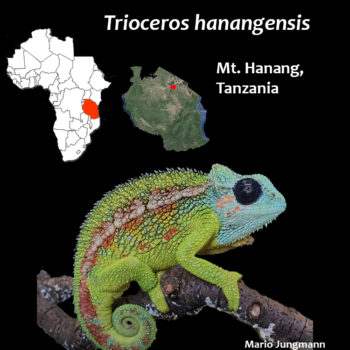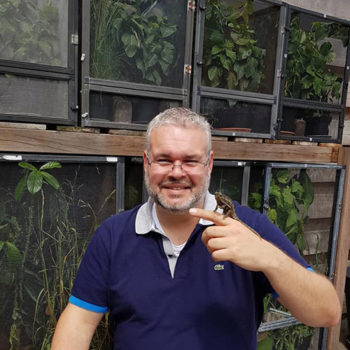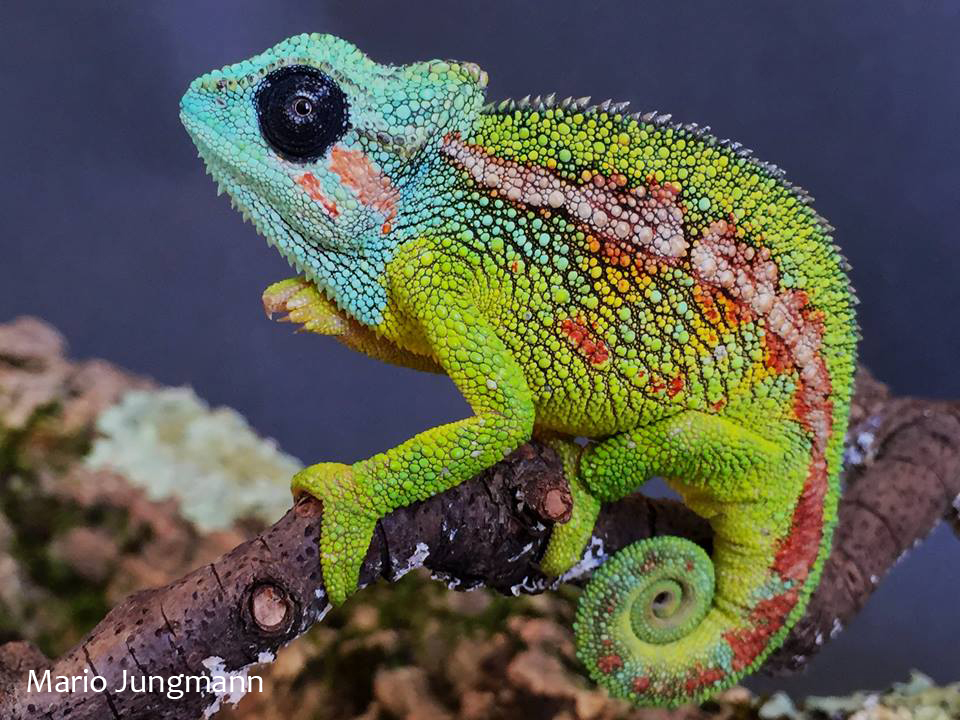Trioceros hanangensis Natural History
Trioceros hanangensis
On the extreme altitude of Mt. Hanang in Tanzania, a curious live bearer was found. Trioceros hanangensis appeared, at first, to be a form of Trioceros sternfeldi which many of us are familiar with (even though we all called it Trioceros rudis for many years). But RNA analysis proved it was its own species. This species is found in the moorlands from 2800 to 3400 meters above sea level.
Trioceros hanangensis is known for its vividly bright colors. It is a live bearer and is rarely imported.
Mario Jungmann has worked with Trioceros hanangensis and introduces us to some natural history highlights of this species.
Mario Jungmann
Trioceros hanangensis

Captive Husbandry
Mario Jungmann is a chameleon breeder out of the Netherlands and specializes in montane chameleons. He has reproduced some of the rarest species in captivity. He offers his insight into breeding and keeping Trioceros hanangensis.
“Trioceros hanangensis is a moorland species from Tanzania, Africa. It is from the higher altitudes and lives above the tree line. I understand that this species is found in low shrubs and vegetation in beautiful meadows of daisy like wild-flowers.
So when we consider their husbandry needs we have to take into account their montane origins.
We learned three main things keeping and breeding this gorgeous species.”

Coloration
“We found out that their very bright coloration can only be maintained with very high levels of UVB. We kept these chameleons outside for much of the year, but noticed that their colors were fading. <Note: Mario lives in the Netherlands where the UV Index is relatively low much of the year>. Outside, both males and females were an olive green with a fishnet black pattern with some red visible. But they were dull. They loved to bask and soaked up as much sun as they could get.
Once the temperature got too high to be outside, we brought them indoors. We exposed them to a UV Index of 5-6 and we saw that their coloration dramatically changed to the impressive vivid colors they are famous for. So the high level of UVB they experience in the wild is necessary to show their best colors.”
Mario speaks about discovering that T. hanangensis needs high UVB to maintain its coloration.
Mario Jungmann
Coloration of Trioceros hanangensis

Appetite
“These are ferocious eaters! They love flying prey. But they have a preference for green and black insects. Green Banana Roaches, Black field crickets, and houseflies were favorite. We would feed them every other day. They are an active species and eat a lot!“
Mario discusses the mighty appetite of this little species
Mario Jungmann
T hanangensis Appetite

Environmental Needs
Temperature
“This species can tolerate high temperatures – even up to 30C/90F. But they NEED a nighttime cooling of at least 10C/18F, and preferably 15C/27F, from their day time ambient temperature. Other keepers that did not give this nighttime drop experienced respiratory infections and death of the animal. This species is a high altitude moorland animal that can actually experience temperatures down to freezing.
Hydration
And this species hates water. Do not spray them. They hate it. So we would spray only at night. We would also fog at night to bring humidity as close to 100% as we could to replicate the cloud environment of the moorlands.
If you can give them the right temperature and humidity in a heavily planted enclosure they are an easy species to keep and breed!”
“

Hear Mario talk about the critical need for a nighttime drop for T. hanangensis
Mario Jungmann
Temperature requirements of T. hanagnesis
Mario shares his successful hydration strategy for breeding T. hanangensis
Mario Jungmann
Hydration of T. hanangensis
Mario finishes up with a short mention of breeding T. hanangensis
Mario Jungmann
Breeding T. hanangensis

